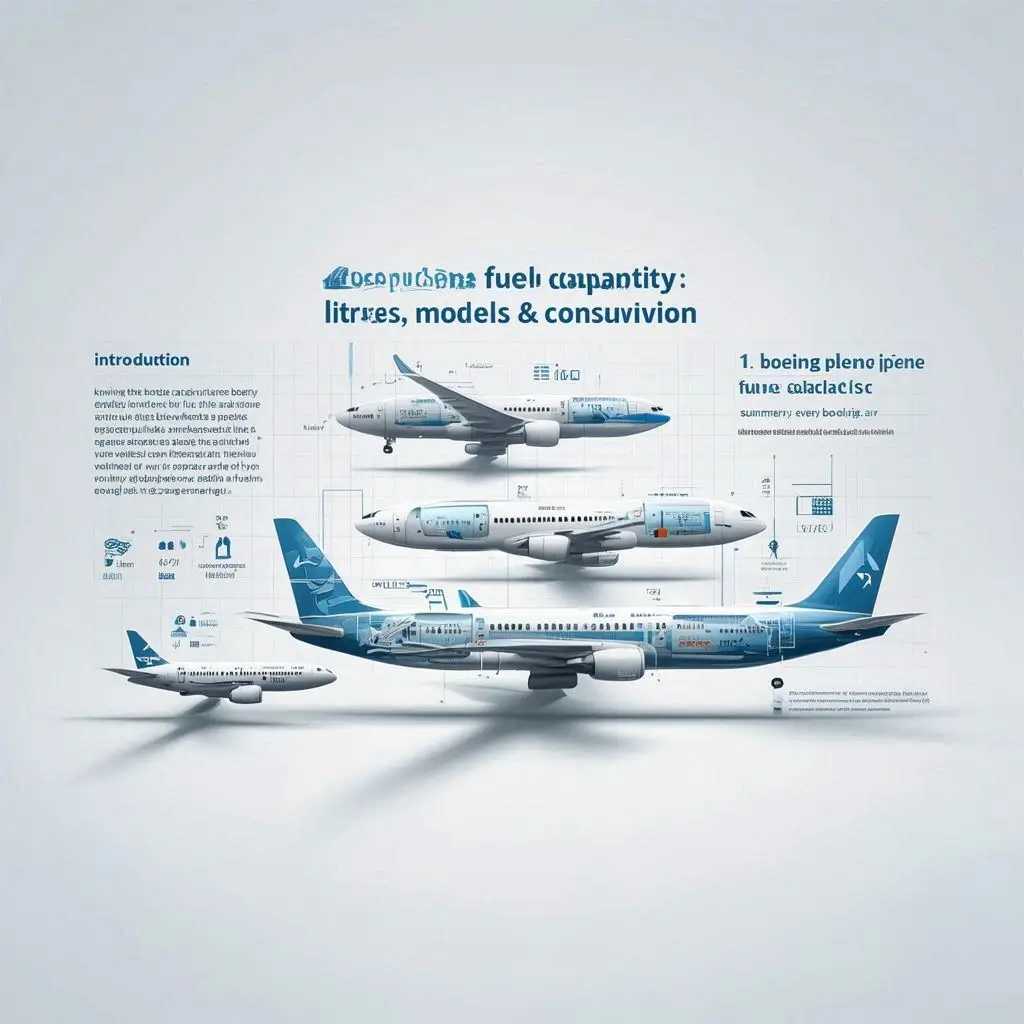
Boeing Plane Fuel Capacity: Litres, Models & Consumption
Introduction
Knowing the fuel capacity of Boeing airplanes is key for aviation professionals, enthusiasts, and travelers curious about how far these giants can fly. This article breaks down the fuel volumes in litres, explores consumption patterns, and highlights specifics of popular Boeing models, helping you grasp the essentials of aircraft fuel management.
1. BOEING PLANE FUEL CAPACITY
Summary: Every Boeing aircraft features a tailored fuel capacity, influencing flight range, weight, and efficiency.
Fuel capacity defines the total volume of jet fuel an airplane’s tanks can hold, often measured in litres worldwide or gallons in the U.S. This capacity varies significantly between models based on their size and flight missions. For example, the wide-body Boeing 747 carries a substantially larger fuel load than the more compact 737, enabling it to cover ultra-long-haul distances.
The right fuel capacity allows airlines to optimize route planning, manage operating costs, and maintain safety standards. Accurate calculations are crucial: too little fuel risks mid-air shortages, while excess fuel adds unnecessary weight and expenses.
External Links:
- Boeing Aircraft Specifications (opens in new tab)
- Federal Aviation Administration (FAA) (opens in new tab)
2. BOEING PLANE FUEL CAPACITY IN LITRES
Summary: Fuel capacity expressed in litres offers global clarity and precision for airlines and ground crews.
While gallons remain common in the U.S., litres provide a universal metric useful for international operations. The Boeing 747-400 model can carry about 216,840 litres of jet fuel—an amount capable of powering transcontinental flights. On the other hand, the Boeing 737-800’s tanks hold approximately 26,020 litres, fitting its role on short- and medium-haul routes.
This conversion to litres aids smoother fuel logistics across countries using the metric system, facilitating better fuel management and planning on a global scale.
External Links:
- Energy Information Administration - Fuel Conversion (opens in new tab)
- Metric Conversions (opens in new tab)
3. BOEING PLANE FUEL CONSUMPTION
Summary: Fuel consumption depends on aircraft design, payload, and flight conditions, influencing efficiency and costs.
Fuel consumption indicates how much jet fuel an aircraft uses during operation, typically measured in litres per hour or per kilometre. Variables like plane model, passenger or cargo load, weather, and cruising altitude all impact fuel burn.
For instance, a Boeing 787 Dreamliner burns approximately 5,600 litres per hour in cruise mode, making it one of the more fuel-efficient wide-body jets. The larger Boeing 747 consumes upwards of 10,000 litres per hour under similar conditions. To reduce costs and environmental impact, Boeing continuously integrates advanced engine technology and aerodynamic improvements into their aircraft.
External Links:
- International Air Transport Association (IATA) (opens in new tab)
- Airbus Fuel Efficiency (opens in new tab)
4. BOEING 747 FUEL CAPACITY AND DESIGN
Summary: Known as an aviation icon, the Boeing 747 boasts one of the largest fuel capacities, supporting long non-stop flights.
Nicknamed the “Jumbo Jet,” the Boeing 747-400 has a colossal fuel capacity of approximately 216,840 litres, distributed across multiple tanks within its wings and fuselage. This extensive fuel volume allows the aircraft to cover distances of up to 13,450 kilometres without refueling.
The tank layout is carefully engineered to balance weight evenly across the airframe, ensuring stable flight dynamics and system redundancy in case of any pump or tank malfunction.
External Links:
- Boeing 747 Overview (opens in new tab)
- Aviation Today (opens in new tab)
5. BOEING 737 FUEL CAPACITY AND EFFICIENCY
Summary: The Boeing 737 family serves as a reliable and fuel-efficient workhorse for short to medium routes.
The Boeing 737-800, a popular variant in this series, carries about 26,020 litres of fuel, adequate for regional and domestic travel up to approximately 5,765 kilometres. The latest models, such as the 737 MAX, incorporate new engine technologies and aerodynamic refinements that significantly reduce fuel consumption, supporting more economical and environmentally friendly operations.
The 737's fuel capacity supports frequent flights with quick turnarounds, making it a favorite among airlines worldwide.
External Links:
- Boeing 737 Series (opens in new tab)
- FAA Aviation Data (opens in new tab)
6. FACTORS AFFECTING BOEING FUEL CONSUMPTION
Summary: Fuel usage is influenced by multiple operational, mechanical, and environmental factors.
Several key elements impact how much fuel a Boeing aircraft consumes during flight:
- Payload Weight: Heavier cargo or passengers increase fuel burn.
- Cruise Altitude and Speed: Flying at optimal levels reduces fuel usage.
- Weather Conditions: Headwinds and turbulence can raise consumption.
- Engine Type: Newer, more efficient engines burn less fuel.
- Maintenance and Aerodynamics: Well-maintained planes with smooth surfaces and clean designs improve fuel economy.
Boeing actively invests in technology and design enhancements to continuously improve fuel efficiency and reduce environmental impact.
External Links:
- NASA Aeronautics Research on Fuel Efficiency (opens in new tab)
- EPA Aviation Environmental Impact (opens in new tab)
Conclusion
Understanding the fuel capacities and consumption rates of Boeing aircraft reveals the complex balance between performance, cost, and sustainability. From the massive tanks of the Boeing 747 enabling global non-stop journeys to the efficient design of the 737 family servicing regional hubs, Boeing’s engineering reflects decades of innovation. Staying informed on these aspects benefits aviation professionals, travelers, and enthusiasts alike.
For expert insights and quality fuel product inquiries, visit www.novintrades.com, your trusted partner in energy and transportation solutions.
FAQs
Q1: How many litres of fuel does a Boeing 787 carry?
A: The Boeing 787 Dreamliner can hold roughly 126,000 litres of jet fuel, supporting its long-range capabilities while maintaining fuel efficiency.
Q2: Why is knowing fuel capacity important for commercial airplanes?
A: Fuel capacity determines how far an aircraft can fly non-stop and directly influences flight safety, weight management, and operational costs.
Q3: How does Boeing improve aircraft fuel consumption?
A: Boeing integrates advanced engines, lightweight materials, improved aerodynamics, and optimized flight systems to reduce fuel burn and emissions.

